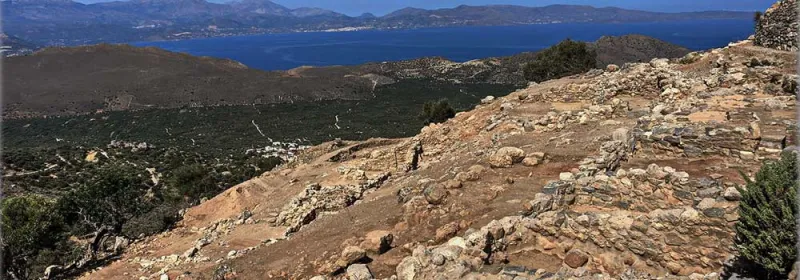
Everyone knows Knossos Palace the home of King Minos of the great Minoan Civilization that thrived 3.000 years ago. Everyone knows Phaistos, the second greatest center of the Minoan Civilization, where the famous Phaistos Disk (not yet deciphered) was discovered. Everyone knows Kydonia another important Minoan center which was located right under the modern city of Chania on the west end of Crete. Everyone knows Ancient Eleftherna, the crossroad among all the above. But very few know about Azoria, an Archaic Greek City of potentially equal importance; the lost city
Azoria is located on a hill overlooking the Gulf of Mirabello in eastern Crete, 1 km southeast of the modern village of Kavousi, and 3 km from the sea. The site occupies a strategic position (365 m above sea level) between the north Isthmus of Ierapetra and the Sitia Mountains. The location was originally explored by the American archaeologist, Harriet Boyd-Hawes, in 1900. Its most important finding was a puzzling series of circular structures superimposed on a large rectangular building. In her 1901 article, she reported finding "latest Mycenaean" and "early Geometric" pottery. Work resumed at the site in 2002, beginning an initial five-year excavation campaign, called the Azoria Project. The Azoria Project excavations have recovered evidence of a city established in 600 BC, following a long period of continuous occupation throughout the Early Iron Age or Greek Dark Age. Although the site has a long history of use the most visible remains are the houses and communal buildings (the Communal Dining Building and the Monumental Civic Building). The city was destroyed by fire early in the 5th century BC, to be subsequently reoccupied on a limited scale. There is evidence for broad-sweeping alterations to the landscape of the site, the construction of monumental buildings, and the reorganization of both civic and domestic space, suggesting aspects of town planning. The Azoria Project excavations have attracted the interest of archaeologists all over the world and have been funded with grants from the National Endowment for the Humanities, National Science Foundation, National Geographic Society, Loeb Classical Library Foundation, American Philosophical Society, Institute for Aegean Prehistory, and the Wenner-Gren Foundation for Anthropological Research.



Airbnb superhost since 2014

Hellenic Association
of Travel & Tourist Agencies
